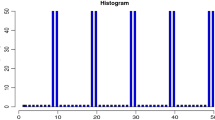Abstract
Simulated maximum likelihood estimates an analytically intractable likelihood function with an empirical average based on data simulated from a suitable importance sampling distribution. In order to use simulated maximum likelihood in an efficient way, the choice of the importance sampling distribution as well as the mechanism to generate the simulated data are crucial. In this paper we develop a new heuristic for an automated, multistage implementation of simulated maximum likelihood which, by adaptively updating the importance sampler, approximates the (locally) optimal importance sampling distribution. The proposed approach also allows for a convenient incorporation of quasi-Monte Carlo methods. Quasi-Monte Carlo methods produce simulated data which can significantly increase the accuracy of the likelihood-estimate over regular Monte Carlo methods. Several examples provide evidence for the potential efficiency gain of this new method. We apply the method to a computationally challenging geostatistical model of online retailing.
Similar content being viewed by others
References
Booth J. G. and Hobert J. P. 1999. Maximizing generalized linear mixed model likelihoods with an automated Monte Carlo EM algorithm. Journal of the Royal Statistical Society B 61: 265–285.
Booth J. G., Hobert J. P., and Jank W. 2001. A survey of Monte Carlo algorithms for maximizing the likelihood of a two-stage hierarchical model. Statistical Modelling 1: 333–349.
Bouleau N. and Lépingle D. 1994. Numerical Methods for Stochastic Processes. Wiley, New York.
Caffo B. S., Booth J. G., and Davison A. C. 2002. Empirical supremum rejection sampling. Biometrika 89: 745–754.
Caflisch R., Morokoff W., and Owen A. 1997. Valuation of mortgage-backed securities using brownian bridges to reduce effective dimension. Journal of Computational Finance 1: 27–46.
Dempster A. P., Laird N. M., and Rubin D. B. 1977. Maximum likelihood from incomplete data via the EM algorithm. Journal of the Royal Statistical Society B 39: 1–22.
Diggle P. J., Tawn J. A., and Moyeed R. A. 1998. Model-based geostatistics. Journal of the Royal Statistical Society A 47: 299–350.
Doornik J. A. 2001. Ox: Object Oriented Matrix Programming. Timberlake, London.
Evans M. and Swartz T. 2000. Approximating Integrals via Monte Carlo and Deterministic Methods. Oxford University Press, Oxford.
Floudas C. and Pardalos P., editors 2001. Encyclopedia of Optimization. Kluwer Academic Publishers.
Halton J. H. 1960. On the efficiency of certain quasi-random sequences of points in evaluating multi-dimensional integrals. Numerische Mathematik 2: 84–90.
Hobert J. P. 2000. Hierarchical models: A current computational perspective. Journal of the American Statistical Association 95: 1312–1316.
Jank W. and Booth J. G. 2003. Efficiency of Monte Carlo EM and Simulated Maximum Likelihood in two-stage hierarchical models. Journal of Computational and Graphical Statistics 12: 214–229.
Kuk A. Y. C. 1999. Laplace importance sampling for generalized linear mixed models. Journal of Statistical Computation and Simulation 63: 143–158.
L’Ecuyer P. 1990. A unified view of the IPA, SF, and LR gradient estimation techniques. Management Science 36(11): 1364–1383.
L’Ecuyer P. 1993. Two Approaches for Estimating the Gradient in Functional Form. In Proceedings of the 1993 Winter Simulation Conference, pages 338–346. IEEE Press.
L’Ecuyer P. 1994. Efficiency improvement via variance reduction. In Proceedings of the 1994 Winter Simulation Conference, pages 122–132. IEEE Press.
L’Ecuyer P. and Lemieux C. 2002. Recent advances in randomized Quasi-Monte Carlo Methods. In Dror M., L’Ecuyer P., and Szidarovszki F., editors, Modeling Uncertainty: An Examination of Stochastic Theory, Methods, and Applications, pages 419–474. Kluwer Academic Publishers.
L’Ecuyer P. 2004. SSJ: A Java Library for Stochastic Simulation. Software user’ guide. Available at http://www.iro.umontreal.ca/lecuyer.
Lemieux C. and L’Ecuyer P. 1998. Efficiency improvement by lattice rules for pricing Asian options. In Proceedings of the 1998 Winter Simulation Conference, pages 579–586. IEEE Press.
Liao J. G. 1998. Variance reduction in Gibbs samplers using quasi-random numbers. Journal of Computational and Graphical Statistics 7: 253–266.
McCullagh P. and Nelder J. A. 1989. Generalized Linear Models. Chapman & Hall, New York.
McCulloch C. E. 1997. Maximum likelihood algorithms for generalized linear mixed models. Journal of the American Statistical Association 92: 162–170.
McCulloch C. E. and Searle, S. R. 2001. Generalized, linear, and mixed models. John Wiley and Sons.
Meng X.-L. and Rubin D. B. 1994. On the Global and Componentwise Rates of Convergence of the EM algorithm. Linear Algebra and its Applications 199: 413–425.
Niederreiter H. 1992. Random Number Generation and Quasi-Monte Carlo Methods. SIAM, Philadelphia.
Owen A. B. 1998. Monte Carlo extension of Quasi-Monte Carlo. In 1998 Winter Simulation Conference Proceedings, pages 571–577. Springer, New York.
Owen A. B. and Zhou Y. 2000. Safe and effective importance sampling. Journal of the American Statistical Association 95: 135–143.
Owen A. B. and Tribble S.D. 2005. A quasi-Monte Carlo Metropolis algorithm. Proceedings of the National Academy of Sciences (to appear).
Pagès G. 1992. Van der Corput sequences, Kakutani transforms and one-dimensional numerical integration. Journal of Computational and Applied Mathematics 44: 21–39.
Searle S. R., Casella G., and McCulloch C. E. 1992. Variance Components. Wiley, New York.
Wang X. and Hickernell F. J. 2000. Randomized Halton sequences. Mathematical and Computer Modelling 32: 887–899.
Wang X. and Fang K.-T. 2003. The effective dimension and quasi-Monte Carlo integration. Journal of Complexity 19: 101–124.
Zhang H. 2002. On estimation and prediction for spatial generalized linear mixed models. Biometrics 58: 129–136.
Zhang P. 1996. Nonparametric importance sampling. Journal of the American Statistical Association 91: 1245–1253.
Author information
Authors and Affiliations
Corresponding author
Rights and permissions
About this article
Cite this article
Jank, W. Efficient simulated maximum likelihood with an application to online retailing. Stat Comput 16, 111–124 (2006). https://doi.org/10.1007/s11222-006-6890-9
Received:
Accepted:
Issue Date:
DOI: https://doi.org/10.1007/s11222-006-6890-9




